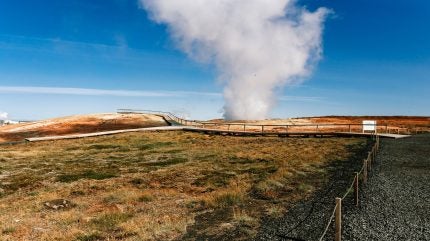Breaking New Ground: H2O.ai, Geothermal Energy Expansion, and Intel’s Strategic Moves
In the fast-evolving landscape of technology and energy, several notable developments are making headlines, each with potential to reshape their respective industries. H2O.ai has unveiled two new vision-language models that aim to redefine document analysis, while the U.S. government is ramping up efforts to expand geothermal energy on public lands. Meanwhile, Intel is actively seeking investors for its chip unit amid increasing competition in artificial intelligence. Let’s dive into these transformative events.
 Innovative AI solutions are changing the landscape of document processing.
Innovative AI solutions are changing the landscape of document processing.
H2O.ai: Challenging Giants with Smaller Models
H2O.ai recently announced the launch of two new vision-language models, H2OVL Mississippi-2B and H2OVL Mississippi-0.8B, surprisingly outpacing much larger models from tech powerhouses when it comes to document analysis and optical character recognition (OCR). What’s fascinating is that the H2OVL Mississippi-0.8B, despite only having 800 million parameters, outperformed its multi-billion parameter competitors on the OCRBench Text Recognition task.
Sri Ambati, CEO and Founder of H2O.ai, emphasized the intention behind these models, stating:
“We’ve designed H2OVL Mississippi models to be a high-performance yet cost-effective solution, bringing AI-powered OCR, visual understanding, and Document AI to businesses.”
He further expounded on the models’ capabilities, which are poised to enhance how businesses process and extract data from documents, even those marred by poor-quality scans or complex handwriting.
The emergence of these models signals a strategic move by H2O.ai to make AI more accessible. By hosting these on Hugging Face, they allow developers to tailor solutions for specific needs, thus widening the opportunities for various industries to leverage AI. As Ambati put it, the release is intended to facilitate an AI movement that champions efficiency and adaptability.
 The new models represent a shift towards smaller, more specialized AI solutions.
The new models represent a shift towards smaller, more specialized AI solutions.
The Shift Towards Document-Centric AI
In an age where businesses are inundated with documents, from contracts to correspondence, the challenge of extracting valuable information is more pressing than ever. Traditional OCR and document analysis systems often falter in less-than-ideal circumstances, yet H2O.ai aims to tackle this head-on. By offering models that can run efficiently on minimal computational resources, they provide a sustainable path forward for enterprises seeking to implement AI without overwhelming their infrastructure.
Industry experts suggest that H2O.ai’s focus on smaller models could disrupt the current dominance of larger tech firms whose exorbitant resources might not align with specific market needs. As the landscape shifts towards more efficient, tailor-made solutions, H2O.ai is positioning itself as a formidable player in enterprise AI.
US Department of Interior: Geothermal Expansion on Public Lands
In parallel, the U.S. Department of the Interior (DOI) has set its sights on expanding geothermal energy on public lands to meet its ambitious goal of a carbon pollution-free power sector by 2035. Recently approved projects, such as the Fervo Cape geothermal power project in Beaver County, Utah, are expected to harness innovative technology to generate up to 2GW of reliable baseload power.
The Bureau of Land Management (BLM) has now authorized nearly 32GW across various clean energy projects, reflecting a commitment to sustainable energy solutions. BLM director Tracy Stone-Manning articulated the importance of geothermal energy, stating:
“We need all the tools in the toolbox to reach a clean energy future.”
This initiative is particularly pertinent as it coincides with the administration’s desire to accelerate clean energy development. Current operational geothermal plants on BLM-managed lands demonstrate the feasibility of tapping into geothermal resources, and recent proposals aim to expedite the identification of new sites for energy generation.
 Geothermal energy expansion can meet the growing need for sustainable power.
Geothermal energy expansion can meet the growing need for sustainable power.
Intel’s Search for Strategic Partnerships
On a different front, Intel is navigating turbulent waters as it looks for investors for its Altera subsidiary. The company’s stock has plunged 55% this year, a stark contrast to the significant financial backing it has received through the CHIPS Act, which awarded Intel $11.5 billion in funding earlier this year.
Despite these resources, Intel faces critical challenges in keeping pace with the advancements in AI technology, as competitors like Qualcomm continue to innovate and grow their market share. CNN reported that Intel’s CEO Pat Gelsinger has acknowledged the necessity of selling part of their stake in Altera to improve liquidity and prepare for an IPO path.
As the semiconductor landscape evolves, Intel’s decision to seek investors highlights the increasing urgency for strategic maneuvers in a space that is both lucrative and cutthroat. Gelsinger’s responses to inquiries about these moves signal Intel’s awareness of the need for adaptability in its business strategies moving forward.
A Future Driven by Innovation
As the narrative unfolds across these developments, one common thread emerges: innovation is vital for survival in today’s fast-paced tech and energy landscapes. Whether through H2O.ai’s ground-breaking AI models tailored for document analysis, the U.S. DOI’s dedication to sustainable geothermal energy, or Intel’s restructuring efforts to remain competitive, each entity’s initiatives reflect a commitment to pushing the boundaries of what’s possible.
Ultimately, the successes and challenges of these companies and government initiatives will impact not only their respective markets but also the broader journey towards technological advancement and environmental stewardship.
In conclusion, as the tech and energy sectors continue to evolve, it is through such bold moves that we may uncover the keys to a more efficient, innovative, and sustainable future.
Tags
- H2O.ai
- Geothermal Energy
- Intel
- Document Analysis
- AI
- Renewable Energy
- Clean Technology
Images
 Visual representation of H2O.ai’s new models showcasing competitive performance.
Visual representation of H2O.ai’s new models showcasing competitive performance.


 Photo by
Photo by 












